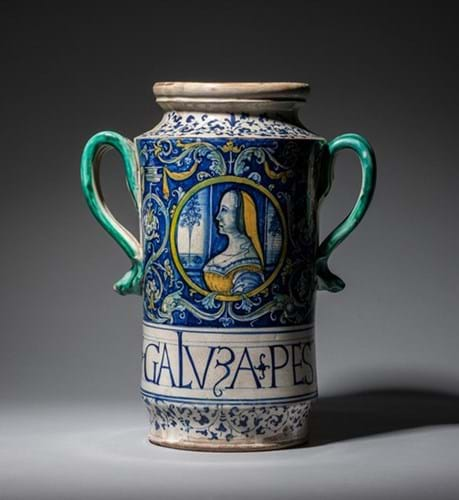
The tin-glazed earthenware drug jar, had been donated through the Cultural Gifts Scheme which allows UK taxpayers to donate important cultural objects in return for a tax bill reduction.
The front of the 14in (35cm) high albarello shows a woman in profile surrounded with masks, garlands and scrollwork on a dark blue ground. The inscription Galviza Pesta suggests it was probably used for storing powdered oak galls. It is believed to have been part of a set made in Siena for the Monastery of Santa Chiara in the close-by town of Massa Maritime.
A total of 12 pieces from the set survive including another jar in the British Museum’s extensive collection of Italian Renaissance tin-glazed earthenware. Other pieces are held by public museums across Europe.
Re-united
The Arts Council said the jars “stand out among surviving albarelli because of their considerable size, rare straight-handled form and their membership to a known set. Though the set has been dispersed, it remains the most extensive body of jars from a single workshop and pharmacy to survive from the early 16th century”.
The jar has been given to the British Museum in honour of Dr Dora Thornton, former curator of Renaissance Europe and the Waddesdon Bequest. Sam Fogg said it was donated “in tribute to her scholarship and her ability to communicate her knowledge to both specialist and wider audiences. Especially notable in the context of this gift is Dora’s remarkable catalogue, co-authored with Timothy Wilson, of the British Museum’s world-class maiolica collections, which has become an essential resource for all of us who love and study these beautiful ceramics.”
The jar, sold at auction in 1977 at Drouot, Paris and again at Sotheby’s New York in 2013. It was bought by Fogg in 2014 from Paris dealership Galerie Vandermeersch.





